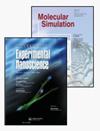鉴定用于2型糖尿病治疗的小分子葡萄糖激酶激活剂:基于结构的虚拟筛选方法
IF 2
4区 化学
Q4 CHEMISTRY, PHYSICAL
引用次数: 0
摘要
摘要葡萄糖激酶(glucokinase, GK, EC 2.7.1.2)是催化葡萄糖转化为葡萄糖-6-磷酸的关键酶。它被用于治疗2型糖尿病(T2D),这是一种严重的代谢紊乱,在没有适当的药物治疗的情况下仍然处于最前沿。快速刚性穷举对接(FRED)对锌数据库中的400,000种化合物进行了快速刚性穷举对接(FRED),以鉴定新的葡萄糖激酶激活剂。命中的化合物ZINC69775727、ZINC9114647、ZINC91773667、ZINC9305321和ZINC96165848与变构位点残基强相互作用,并与ARG 63形成氢键。根据ADME的预测,命中的化合物符合药物相似的标准。然后用DESMOND进行100 ns的分子动力学模拟和MM-GBSA计算。研究结果表明,这些化合物在整个模拟过程中具有良好的稳定性和最小的波动,这表明所选化合物具有葡萄糖激酶激活的潜力。其中,ZINC69775727的结合能最低,为- 111.1 kcal/mol,低于天然配体的- 102.84 kcal/mol,也低于对照化合物PSN-GK1和Piragliatin的- 102.49 kcal/mol和- 107.767 kcal/mol。因此,这项工作的信息可能有助于寻找新的小分子作为gka。关键词:葡萄糖激酶(GK)葡萄糖激酶激活剂(GKA)FREDDESMONDzinc数据库致谢chelliah Selvam感谢Openeye公司提供使用对接工具的学术许可。披露声明作者未报告潜在的利益冲突。本文章由计算机程序翻译,如有差异,请以英文原文为准。
Identification of small-molecule glucokinase activator for type-2-diabetes treatment: a structure-based virtual screening approach
ABSTRACTGlucokinase (GK, EC 2.7.1.2) is a crucial enzyme that catalyses the conversion of glucose to glucose-6-phosphate. It is used to treat type-2 diabetes (T2D), a serious metabolic disorder that is still at the forefront without proper medication. Fast Rigid Exhaustive Docking (FRED) was carried out for 400,000 compounds from the Zinc database to identify novel glucokinase activators. The hit compounds ZINC69775727, ZINC9114647, ZINC91773667, ZINC9305321, and ZINC96165848 interacted strongly with allosteric site residues and, formed hydrogen bonds with ARG 63. The hit compounds met the criterion for drug-likeness, according to the ADME prediction. The compounds were then subjected to 100 ns of molecular dynamics simulation and MM-GBSA calculation using DESMOND. The findings demonstrated that the compounds had good stability and minimal fluctuation throughout the course of the simulation, pointing to the potential of the chosen compounds for glucokinase activation. The compound ZINC69775727 in particular has the lowest binding energy of −111.1 kcal/mol, which is lower than the native ligand’s binding energy of −102.84 kcal/mol and the binding energies of the control compounds PSN-GK1 and Piragliatin, which are −102.49 kcal/mol and −107.767 kcal/mol, respectively. Therefore, the information from this work may be useful in finding novel small molecules as GKAs.KEYWORDS: Glucokinase (GK)glucokinase activators (GKA)FREDDESMONDzinc database AcknowledgementChelliah Selvam thanks the Openeye Inc for providing the academic license to use the docking tools.Disclosure statementNo potential conflict of interest was reported by the author(s).
求助全文
通过发布文献求助,成功后即可免费获取论文全文。
去求助
来源期刊

Molecular Simulation
化学-物理:原子、分子和化学物理
CiteScore
3.80
自引率
9.50%
发文量
128
审稿时长
3.1 months
期刊介绍:
Molecular Simulation covers all aspects of research related to, or of importance to, molecular modelling and simulation.
Molecular Simulation brings together the most significant papers concerned with applications of simulation methods, and original contributions to the development of simulation methodology from biology, biochemistry, chemistry, engineering, materials science, medicine and physics.
The aim is to provide a forum in which cross fertilization between application areas, methodologies, disciplines, as well as academic and industrial researchers can take place and new developments can be encouraged.
Molecular Simulation is of interest to all researchers using or developing simulation methods based on statistical mechanics/quantum mechanics. This includes molecular dynamics (MD, AIMD), Monte Carlo, ab initio methods related to simulation, multiscale and coarse graining methods.
 求助内容:
求助内容: 应助结果提醒方式:
应助结果提醒方式:


